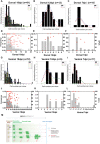In Vivo Clonal Analysis Reveals Development Heterogeneity of Oligodendrocyte Precursor Cells Derived from Distinct Germinal Zones
- PMID: 34396711
- PMCID: PMC8529438
- DOI: 10.1002/advs.202102274
In Vivo Clonal Analysis Reveals Development Heterogeneity of Oligodendrocyte Precursor Cells Derived from Distinct Germinal Zones
Abstract
Mounting evidence supports that oligodendrocyte precursor cells (OPCs) play important roles in maintaining the integrity of normal brains, and that their dysfunction is the etiology of numerous severe neurological diseases. OPCs exhibit diverse heterogeneity in the adult brain, and distinct germinal zones of the embryonic brain contribute to OPC genesis. However, it remains obscure whether developmental origins shape OPC heterogeneity in the adult brain. Here, an in vivo clonal analysis approach is developed to address this. By combining OPC-specific transgenes, in utero electroporation, and the PiggyBac transposon system, the lineages of individual neonatal OPCs derived from either dorsal or ventral embryonic germinal zones are traced, and the landscape of their trajectories is comprehensively described throughout development. Surprisingly, despite behaving indistinguishably in the brain before weaning, dorsally derived OPCs continuously expand throughout life, but ventrally derived OPCs eventually diminish. Importantly, clonal analysis supports the existence of an intrinsic cellular "clock" to control OPC expansion. Moreover, knockout of NF1 could circumvent the distinction of ventrally derived OPCs in the adult brain. Together, this work shows the importance of in vivo clonal analysis in studying stem/progenitor cell heterogeneity, and reveals that developmental origins play a role in determining OPC fate.
Keywords: NF1; developmental origin; heterogeneity; homeostasis; in vivo clonal analysis; oligodendrocyte precursor cell.
© 2021 The Authors. Advanced Science published by Wiley-VCH GmbH.
Conflict of interest statement
The authors declare no conflict of interest.
Figures








References
Publication types
MeSH terms
Substances
Grants and funding
- 2016YFA0101201/National Key Research and Development Program of China Stem Cell and Translational Research
- 81673035/National Natural Science Foundation of China
- 81972915/National Natural Science Foundation of China
- LR17H160001/Science Foundation for Distinguished Young Scientists of Zhejiang Province
- 2016QNA7023/Fundamental Research Funds for the Central Universities
LinkOut - more resources
Full Text Sources
Research Materials
Miscellaneous
